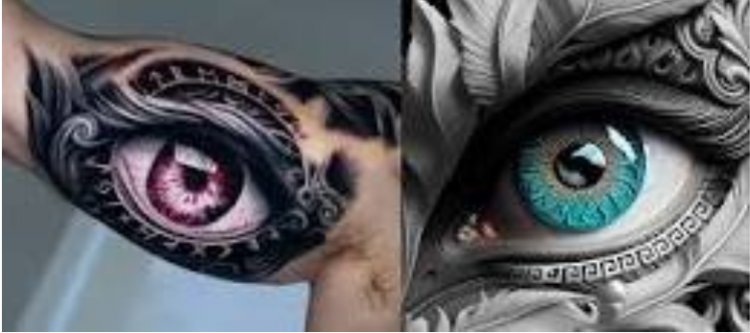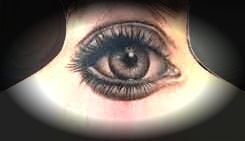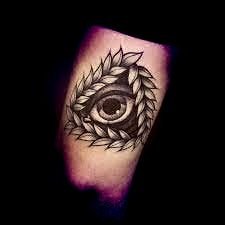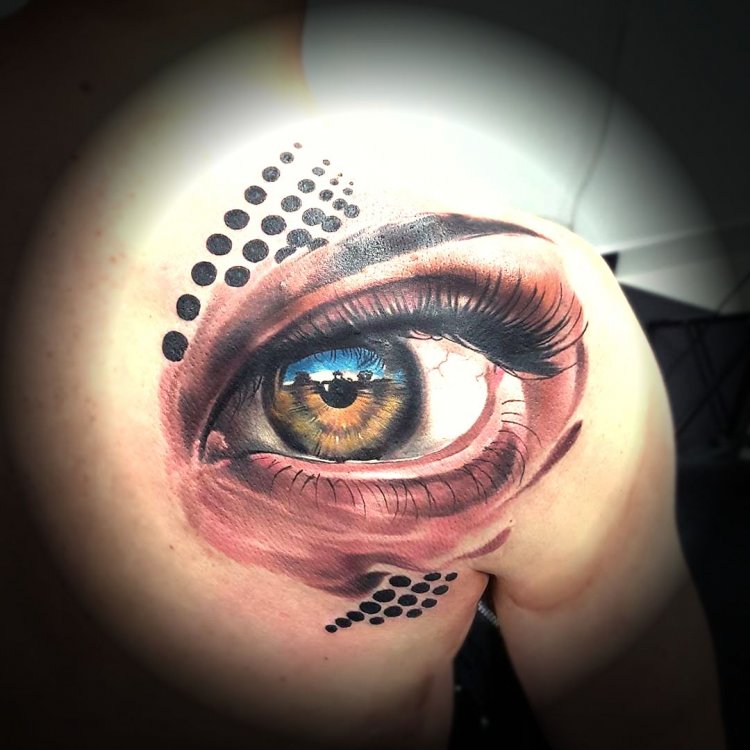Eye Tattoo Design
Eye tattoo design: Intricate and symbolic, it captures mystique and insight. Variations include realistic, abstract, or cosmic styles, conveying depth and perception through inked artistry.

Information:
Eye tattoos are a very ancient practice, or at least it was common to use an amulet in the shape of an eye as protection against negative influences.Many cultures have continued to use the eye as a protective emblem and from this tradition, many of the meanings of eye tattoos draw inspiration today.If we follow the common thread of this tradition, we can also see the eye as the “mirror of the soul”.Many cultures have used the symbol of the eye in their constructions and the engraving of elements such as amphorae, military instruments, or in the temples of worship themselves, which is why the eye has remained throughout time as one of the universal symbols of protection.
The most famous Eye of Horus tattoos:
The eye of Horus, which represents the Sun, is widely used as a tattoo: it is an ancestral magical sign, a desire for regeneration that the Egyptians represented and which is known throughout the world. In ancient Egypt, the hieroglyph for deity was the eye, which in hieroglyphic language means to see and also to create.Many Egyptian tattoos have an eye in part of their composition and it is that tattoos of the eye of Horus are common in any part of the world, due to their beauty and aesthetic and because of the meaning it contains, for both men and women, it is a design that looks great on almost any part of the body.
What is the meaning of eye tattoos?
Visualization is the ability to create a mental image, a potential that we all have and always use, consciously or not. Therefore, the eye can be a symbol of creativity and personal healing.
How to properly take care of eye tattoos?
It is necessary to care for tattoos in the eyes very carefully and in accordance with the instructions of a specialist. Lack of proper caution and care can lead to serious complications and even loss of vision. Some general recommendations:
- Avoid touching or scratching your eye, especially in the first few weeks after the procedure.
- Avoid contact with water, dust and dirt.
- Maintain eye hygiene: wash them regularly using antiseptic agents.
- Monitor for symptoms of complications and contact your doctor immediately if any problems occur.

History of Eye Tattoo:
Historical Background Tattooing has a long history that spans numerous cultures and times. As a particular subset of this art, eye tattoos have a distinct historical background. the Old World The practice of getting tattoos has a long history. However, in those early times, getting an eye tattoo was more common as a medicinal or religious ritual than for cosmetic reasons. For instance, the ancient Greeks and Romans attempted to heal numerous eye conditions and corneal defects by tattooing the eyes. The Development of Cosmetic Ink Eye tattoos remained more of a medical treatment than a fashion accessory until the 19th century. To treat eye abnormalities, many needle kinds and colors were employed.Little was known at the time about the potential outcomes of such treatments. Making the Switch to Cosmetic Tattoos The perception of eye tattoos as an aesthetic surgery first emerged at the turn of the 20th century. The advancement of cosmetic surgery and cosmetic corrective methods is to blame for this. A process that allowed both men and women to modify the color of their eyes was created to alter the iris' color and provide decorative effects.
The most obscene and frightening trend is tattooing eyes. The soul's reflection is in the eyes. There are people who have made the extreme decision to permanently change the color of their eyes, and yet we are still shocked when we see someone on the street wearing strange contact lenses. There are very few masters in the world who are familiar with this peculiar procedure, and it is very controversial.Tattoos of eyes are a novel fashion. Nobody will be unaffected by such a drastic shift in look; some people will be horrified and others will be delighted. The terrifying process is risky, and the effects last for a very long period.

The practice of tattooing the eyes:
Eyeball tattoos have existed for a while. Ancient Rome and Ancient Greece first started iris decoration to get rid of uncomfortable white patches. The 19th century saw a rise in the usage of the practice. With the aid of tattooing, they attempted to repair the cornea. Different needles and inks were used by doctors. Since even doctors and patients were not completely informed of the potential dangers of utilizing dyes, the surgeries were not ethical enough.
Nowadays, one of the treatments carried out in cosmetology clinics is altering the cornea's color. The first eyeball tattoo was created and applied by Toronto tattoo artists Shannon Larratt and Luna Cobra back in 2007.
How to create an eyeball tattoo?
Eyeball tattooing isn't actually a tattoo, strictly speaking. The procedure is more akin to an injection; the tattoo artist inserts a needle into the sclera and injects colored ink into the eyeball using a syringe. To create the appropriate visual impact, you can only combine colors throughout the full space of the sclera, making it nearly impossible to "draw" on the eyes. There is no discernible difference between male and female tattoos on the eyeball, with the possible exception of colors. Men can select vibrant multicolored alternatives, while women can select an ominous black fill.The procedure for getting a tattoo on the eyeball looks quite scary. This is what a master does.
First instills an anesthetic drug;
Then injects the pigment into the iris or sclera with a very thin needle;
Removes the needle and wipes off any remaining paint.

The finest and worst eyeball tattoo designs:
Australian tattoo enthusiast Amber Luke is a fan. Her body has more than 200 tattoos and piercings, her teeth resemble vampire teeth, and an eyeball tattoo should have been a significant complement to the overall aesthetic, in her opinion. But things did not turn out the way she had anticipated. She went blind for three weeks after a 40-minute eyeball tattoo surgery. Thankfully, her vision came back, but Amber had not anticipated such a reaction.
Background of the process:
Eyeball coloring has been done since the dawn of mankind. The practice has a roughly 2,000-year history. Galen, an ancient Roman physician and philosopher who made a substantial contribution to the development of anatomy, is where we first learn about extreme cosmetic alteration.Since ancient times, people have had tattoos on their eyes.
The ancient doctor, who is renowned for his surgical procedures, is regarded as the father of modern medicine. He is recognized as having invented the first keratopigmentation technology. In 150 BC, Galen provided instructions on how to carry out a novel cosmetic operation.An ancient and fascinating history is manipulated in an eyeball tattoo. It is mentioned in the 450 BC writings of the ancient Roman physician Flavius Aetius. The severe treatment, according to the author, was used to mask leukomatous corneal opacities. A heated stylet tip was used to cauterize the surface of the visual organ.

Following that a colorful pigment derived from:
pomegranate bark that has been powdered, iron filings, pulverized nut shells, and a salt-copper sulfate solution.
Ancient doctors promoted the treatment as a way to hide cataracts (leukoma) rather than as a way to change one's appearance in an attractive way. Despite being described in ancient literature, keratopigmentation information wasn't discovered until 1869. the nineteenth century.
The French surgeon actively developed oculoplastic, a then-novel field of aesthetic medicine that entailed the repair of facial flaws:
Lacrimal glands: skin around the eyes; face muscles; and century. The use of colored inks and natural dyes to alter the visual and esthetic properties of the visual organ was pioneered by Louis de Wecker. Cocaine served as his local anesthetic. The dye solution was injected into the ocular tissues using a special needle with an exterior groove. Louis de Wecker's method of keratopigmentation, which served as the foundation for further advancements in the cosmetics business, had a considerable influence on the advancement of cosmetic operations.
What's Your Reaction?





















